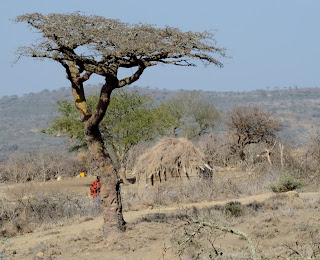 |
| she had the loveliest smile! |
 | |
| a Maasai village on the edge of the Ngorongoro Crater |
Instantly identifiable, Maasai men drape themselves in toga-like red and plaid blankets, carry long wooden poles, and often dye their hair with red ochre and style it in a manner that has been compared to a Roman helmet.
The women have a distinctive look too. They keep their heads shaved or their hair extremely short and create and wear elaborate beaded jewelry and adornments.
The Maasai measure a man's wealth in terms of cattle and children rather than money. Traditionally, the Maasai will not hunt or eat vegetable matter or fish, but feed almost exclusively on cattle.
 |
| a Maasai home in the Lake Manyara region |
The central unit of Maasai society is the age-set. Every 15 years or so, a new and individually named generation of warriors or limoran will be initiated, consisting of all young men who have reached puberty and are not part of the previous age-set. Their age range is usually 12 to 25.
During the initiation period - which includes a circumcision - the boys are not allowed to work. They dress all in black and paint their faces with white geometric designs. We were constantly passing groups of them just standing around on the side of the road as we made our way through Northern Tanzania.
 As our friend Ric was quite fond of saying, "You're gonna love it!"
As our friend Ric was quite fond of saying, "You're gonna love it!"








Always learning from your blog! I spent some time with them in the Mara and thought they were so beautiful and smart and tough. Don't recall seeing the white faced ones tho.
ReplyDeleteI didn't remember seeing them the last time I was in the region either. They only do it every 15 years or so. We were just in the right place at the right time!
Delete